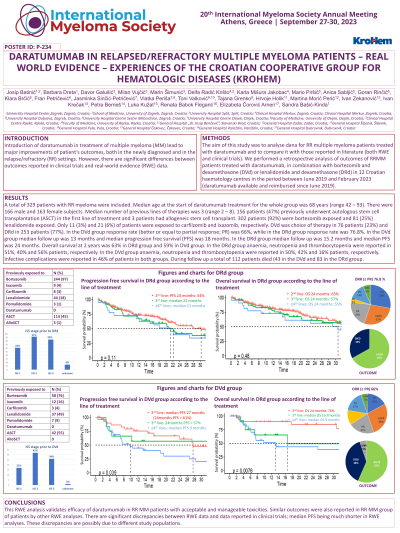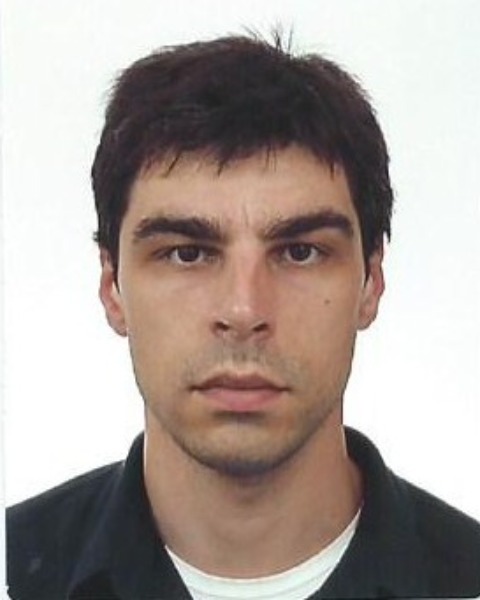Treatment of Relapsed/Refractory Myeloma
Poster Session 2
P-234: DARATUMUMAB IN RELAPSED/REFRACTORY MULTIPLE MYELOMA PATIENTS – REAL WORLD EVIDENCE – EXPERIENCES OF THE CROATIAN COOPERATIVE GROUP FOR HEMATOLOGIC DISEASES (KROHEM)
Thursday, September 28, 2023
12:30 PM - 1:30 PM EEST


Josip Batinić
attending physician
University Hospital Centre Zagreb; School of Medicine, University of Zagreb
Zagreb, Croatia
Introduction: Introduction of daratumumab in treatment of multiple myeloma (MM) lead to major improvements of patient’s outcomes, both in the newly diagnosed and in the relapse/refractory (RR) settings. However, there are significant differences between outcomes reported in clinical trials and real-world evidence (RWE) data. The aim of this study was to analyze data for RR multiple myeloma patients treated with daratumumab and to compare it with those reported in literature (both RWE and clinical trials).
Methods: We performed a retrospective analysis of outcomes of RRMM patients treated with daratumumab, in combination with bortezomib and dexamethasone (DVd) or lenalidomide and dexamethasone (DRd) in 12 Croatian hematology centers in the period between June 2019 and February 2023 (daratumumab available and reimbursed since June 2019).
Results: A total of 329 patients with RR myeloma were included. Median age at the start of daratumumab treatment for the whole group was 68 years (range 42 – 93). There were 166 male and 163 female subjects. Median number of previous lines of therapies was 3 (range 2 – 8). 156 patients (47%) previously underwent autologous stem cell transplantation (ASCT) in the first line of treatment and 3 patients had allogeneic stem cell transplant. 302 patients (92%) were bortezomib exposed and 81 (25%) lenalidomide exposed. Only 11 (3%) and 21 (6%) of patients were exposed to carfilzomib and ixazomib, respectively. DVd was choice of therapy in 76 patients (23%) and DRd in 253 patients (77%). In the DVd group response rate (better or equal to partial response; PR) was 66%, while in the DRd group response rate was 76.8%. In the DVd group median follow up was 13 months and median progression free survival (PFS) was 18 months. In the DRd group median follow up was 15.2 months and median PFS was 24 months. Overall survival at 2 years was 63% in DRd group and 59% in DVd group. In the DRd group anemia, neutropenia and thrombocytopenia were reported in 51%, 40% and 56% patients, respectively. In the DVd group anemia, neutropenia and thrombocytopenia were reported in 50%, 42% and 16% patients, respectively. Infective complications were reported in 46% of patients in both groups. During follow up a total of 112 patients died (43 in the DVd and 83 in the DRd group.
Conclusions: This RWE analysis validates efficacy of daratumumab in RR MM patients with acceptable and manageable toxicities. Similar outcomes were also reported in RR MM group of patients by other RWE analyses. There are significant discrepancies between RWE data and data reported in clinical trials; median PFS being much shorter in RWE analyses. These discrepancies are possibly due to different study populations.
Methods: We performed a retrospective analysis of outcomes of RRMM patients treated with daratumumab, in combination with bortezomib and dexamethasone (DVd) or lenalidomide and dexamethasone (DRd) in 12 Croatian hematology centers in the period between June 2019 and February 2023 (daratumumab available and reimbursed since June 2019).
Results: A total of 329 patients with RR myeloma were included. Median age at the start of daratumumab treatment for the whole group was 68 years (range 42 – 93). There were 166 male and 163 female subjects. Median number of previous lines of therapies was 3 (range 2 – 8). 156 patients (47%) previously underwent autologous stem cell transplantation (ASCT) in the first line of treatment and 3 patients had allogeneic stem cell transplant. 302 patients (92%) were bortezomib exposed and 81 (25%) lenalidomide exposed. Only 11 (3%) and 21 (6%) of patients were exposed to carfilzomib and ixazomib, respectively. DVd was choice of therapy in 76 patients (23%) and DRd in 253 patients (77%). In the DVd group response rate (better or equal to partial response; PR) was 66%, while in the DRd group response rate was 76.8%. In the DVd group median follow up was 13 months and median progression free survival (PFS) was 18 months. In the DRd group median follow up was 15.2 months and median PFS was 24 months. Overall survival at 2 years was 63% in DRd group and 59% in DVd group. In the DRd group anemia, neutropenia and thrombocytopenia were reported in 51%, 40% and 56% patients, respectively. In the DVd group anemia, neutropenia and thrombocytopenia were reported in 50%, 42% and 16% patients, respectively. Infective complications were reported in 46% of patients in both groups. During follow up a total of 112 patients died (43 in the DVd and 83 in the DRd group.
Conclusions: This RWE analysis validates efficacy of daratumumab in RR MM patients with acceptable and manageable toxicities. Similar outcomes were also reported in RR MM group of patients by other RWE analyses. There are significant discrepancies between RWE data and data reported in clinical trials; median PFS being much shorter in RWE analyses. These discrepancies are possibly due to different study populations.
